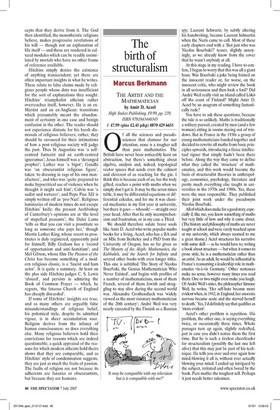The birth of structuralism
Marcus Berkmann THE ARTIST AND THE MATHEMATICIAN by Amir D. Aczel _High Stakes Publishing, £9.99, pp. 239, ISBN 9781843440345 © £7.99 (plus £2.45 p&p) 0870 429 6655 f all the sciences and pseudosciences that clamour for our attention, none is a tougher sell than pure mathematics. The British have never been noticeably keen on abstraction, but there's something about algebra, analysis and, indeed, topological vector spaces that sends even the calmest and cleverest of us reaching for the gin. I think this is because each of us, bar the truly gifted, reaches a point with maths when we simply don't get it. It may be the seven times table, it may be differential equations or differential calculus, and for me it was classical mechanics in my first year at university, but there it goes — whoosh! — straight over your head. After that lie only incomprehension and frustration, or in my case a Third.
We should therefore salute brave souls like Amir D. Aczel who write popular maths books for a living. Aczel, who has a BA and an MSc from Berkeley and a PhD from the University of Oregon, has so far given us The Mystery of the Aleph: Mathematics, the Kabbalah, and the Search for Infinity and several other books with even longer titles. This one is subtitled 'The Story of Nicolas Bourbaki, the Genius Mathematician Who Never Existed', and begins with profiles of a number of mathematicians, most of them French, several of them Jewish and struggling to stay alive during the second world war. Alexandre Grothendieck was 'widely viewed as the most visionary mathematician of the 20th century'; Andre Weil was very nearly executed by the Finnish as a Russian spy; Laurent Schwartz, by subtly altering his handwriting, became Laurent Selmartin when the Nazis came to call. Most of these early chapters end with a 'But just who was Nicolas Bourbaki?' teaser, slightly annoyingly, as we already know from the cover that he wasn't anybody at all.
At this stage in my reading, I have to confess, I began to worry that this was all a giant hoax. Was Bourbaki a joke being foisted on the innocent reader or, far worse, on the innocent critic, who might review the book in all seriousness and then look a fool? Did Andre Weil really visit an island called Lao off the coast of Finland? Might Amir D. Aczel be an anagram of something fantastically rude?
You have to ask these questions, because the tale is so unlikely. Maths is traditionally a solitary pursuit, created by men (and a few women) sitting in rooms staring out of windows. But in France in the 1930s a group of young mathematicians banded together and decided to rewrite all maths from basic principles upwards, introducing a fierce intellectual rigour that simply hadn't been there before. Along the way they came to define what they called the 'structure' of mathematics, and this work would become the basis of structuralist theories in anthropology, economics, psychology, literature and pretty much everything else taught in universities in the 1970s and 1980s. Yes, these were the men responsible. They published their joint work under the pseudonym Nicolas Bourbaki.
All of which does make for a good story, especially if like me, you know something of maths but very little of how and why it came about. (The history and philosophy of maths are never taught at school and were rarely touched upon at my university, which always seemed to me a great shame.) Aczel structures his narrative with some skill — as he would have to, writing a book about structure but when it comes to prose style, he is a mathematician rather than an artist. 'As an adult, he would be influential in France's reassuming a leadership role in mathematics vis-a-vis Germany.' Other sentences make no sense, however many times you read them. One or two might even make you laugh. Of Andre Weil's sister, the philosopher Simone Weil, he writes, 'Her self-hate became more evident when, in 1942, in England, her anorexia nervosa became acute and she starved herself to death.' Yes, I'd definitely say that qualifies as 'more evident'.
Aczel's other problem is repetition. His problem, the other one, is saying everything twice, or occasionally three times. Whole passages turn up again, slightly redrafted, just in case you didn't notice them the first time. But he is such a tireless cheerleader for structuralism (possibly the last one left alive) that this may just be part of his technique. He tells you over and over again how mind-blowing it all is, without ever actually blowing your mind. I ended up intrigued by the subject, irritated and often bored by the book. Pure maths: the toughest sell. Perhaps it just needs better salesmen.



















































 Previous page
Previous page